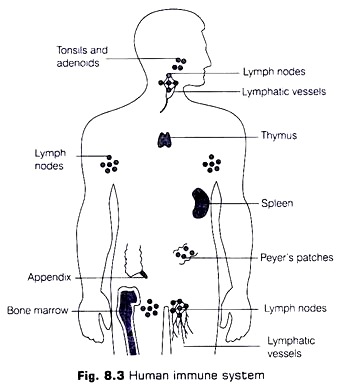In this article we will discuss about the primary and secondary lymphoid organs.
Primary Lymphoid Organs:
In primary lymphoid organs, immature lymphocytes differentiate to mature ones into an antigen sensitive lymphocytes and after maturation, lymphocytes migrate to secondary lymphoid organs.
These are of two types:
(a) Bone marrow
(b) Thymus
(a) Bone Marrow:
It is the main lymphoid organ, where all the lymphocytes and all the body cells are produced and T-lymphocytes are developed.
(b) Thymus:
It is a lobed organ, located near the heart and beneath the breast bone. It is large at the time of birth but with age, the size keep on reducing and becomes very small by attaining puberty. Growth and maturation of T-lymphocytes takes place in thymus only.
Note:
Both bone marrow and thymus provide micro-environments for the development and maturation of T-lymphocytes.
Secondary Lymphoid Organs:
These organs provide the sites for the interaction of lymphocytes with the antigen, which then proliferate to become effector cells.
These are of following types:
(a) Spleen,
(b) Lymph nodes,
(c) Mucosal associated Lymphoid Tissue (MALT)
Peyer’s patches of small intestine and appendix are also some of the secondary lymphoid organs.
(a) Spleen:
It is a large bean-shaped organ containing lymphocytes and phagocytes. It filters the blood by trapping the pathogens in it.
(b) Lymph Nodes:
These are small solid structures located at different points along the lymphatic system. Their function is to trap the microorganisms or other antigens, that enter the lymph and tissue fluid. Therefore, the antigens trapped in the lymph nodes are responsible for the activation of lymphocytes present there and cause the immune response.
(c) Mucosal Associated Lymphoid Tissue (MALT):
This is located within the lining of main tracts in the body like respiratory, digestive, urogenital tracts. MALT constitutes about 50% of the lymphoid tissue in human body.
